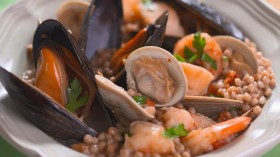Last Updated on March 7, 2016
 Ingredients
Ingredients
4 tablespoons extra virgin olive oil
8 small sea scallops
8 medium shrimp, shelled and de-veined
1/4 cup finely chopped shallots
2 garlic cloves, minced (about 2 teaspoons)
3 plum tomatoes (about 8 ounces), finely chopped
1 cup white wine
1 dozen mussels, scrubbed and de-bearded
1 dozen littleneck clams, scrubbed
1 to 1 1/2 cups canned chicken broth or stock
1 cup pearl or Israeli couscous
Kosher salt and freshly milled black pepper
Directions
Heat 2 tablespoons of the oil in a large skillet over high heat until hot; reduce the heat to medium-high and add the scallops and the shrimp. Cook, turning once, until almost cooked through, about 2 minutes total. Transfer the shellfish with tongs to a strainer set over a bowl and set aside.
Add the shallots to the pan and cook over medium-low heat until softened, about 2 minutes. Add the garlic and cook, stirring 1 more minute. Add the tomatoes and cook for 3 minutes. Add the white wine, mussels, and clams. Cover and increase the heat to high. Steam for 3 to 5 minutes, transferring the mussels and clams as they open to the strainer with the shrimp and scallops. Discard any mussels and clams that do not open. Measure the tomato mixture in the skillet; add the liquid from the bowl under the shellfish and enough chicken broth to make 2 cups.
Heat the remaining 2 tablespoons oil in a saucepan over medium heat and add the couscous. Cook, stirring, for 3 minutes. Add the 2 cups liquid and bring to a boil. Turn it down to a simmer, cover the pan tightly and cook for 5 minutes or until the couscous is tender.
Meanwhile, remove and discard the mussel and clam shells, if desired. Add the shellfish to the couscous along with any more juices from the bowl; cook until just heated through. Add salt and pepper to taste and serve.
Arugula Salad with Croutons, Sliced Spanish Olives, Halved Cherry Tomatoes and Creamy Garlic Dressing
6 to 8 cups Arugula
1/2 cup store-bought croutons
1/3 cup sliced Spanish olives
1 cup halved cherry tomatoes
Wash arugula and pat dry. Sprinkle with croutons. Slice olives and tomatoes.
Toss in large serving bowl. Serve with Creamy Garlic Dressing. Recipe below.
Creamy Garlic Dressing Two Ways: Rich and Slim
Makes about 2/3 cup
1 tablespoon sherry vinegar
1 teaspoon Dijon mustard
1/4 teaspoon kosher salt
1/8 teaspoon freshly ground black pepper
1 teaspoon minced garlic
1/4 cup heavy cream or plain low-fat or full-fat yogurt Greek-style yogurt
1/4 c extra virgin olive oil
Whisk together the vinegar, mustard, salt, and pepper in a small bowl until the salt has dissolved. Stir in the garlic and gradually whisk in the cream (or yogurt) and then the olive oil. Store in the refrigerator for a day or two.
COOK’S NOTES
Couscous is actually small grains of semolina pasta. It ranges in size from miniscule to pea size balls, known as pearl or Israeli couscous, which works beautifully in this shellfish dish. Another option is fregola, a small round dry pasta from Sardinia.
Winter months are the peak time for scallop availability and quality. Look for Cape and Nantucket Bay scallops. The two are identical species from different waters surrounding Cape Cod, Nantucket and Martha’s Vineyard. Their season begins anywhere from the first of October to the first of November. Only 10,000 to 100,000 pounds are harvested per year. Although expensive, these rare, sustainable and well managed scallops are well worth the price. Also available live in shell, they are referred to by many as the best tasting scallop.
You will want to buy “dry,” scallops which means no chemicals, including tripolyphosphate (a preservative that allows scallops to absorb water) or water is added. If they have been soaked in a preservative or water you are paying for that extra water weight and the scallops will have an inferior taste and be impossible to saute (they will give off too much liquid).
Clams can be divided into two categories – hard shell varieties (such as quahogs, cherrystones and littlenecks) and soft shell varieties (such as steamers and razor clams). Hard shells live along sandy beaches and bays; soft shells in muddy tidal flats.
Most of the mussels available in the market today are cultivated. Although there are dozens of different species, the two mostly widely available are the Atlantic blue or common mussel and the Pacific green-lipped or New Zealand mussel.
If they have a little tuft of fibers hanging out of them, aka a beard (which the mussel uses to connect to rocks or pilings) you can cut or scrape it off with a knife or scissors. You may also pull it sharply down toward the hinged point of the shells with your fingers. Do not debeard mussels more than 1 hour before cooking.


